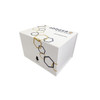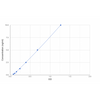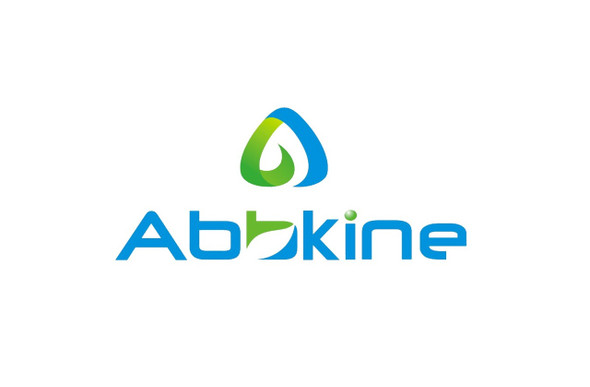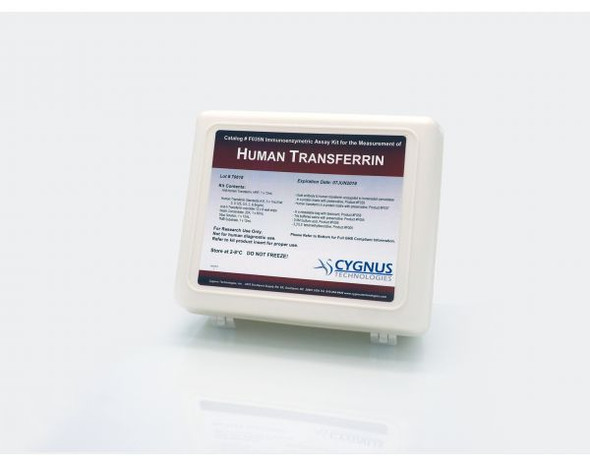Human Asprosin ELISA Kit | abx257694
- SKU:
- abx257694
- Availability:
- Shipped within 5-12 working days.
- Clonality:
- N/A
- Tested Applications:
- ELISA
- Host:
- N/A
- Conjugation:
- N/A
- Dry Ice:
- No
Description
Human Asprosin ELISA Kit. Cat# abx257694. Supplier: abbexa.
Human Asprosin ELISA Kit is an ELISA Kit for the in vitro quantitative measurement of Human Asprosin concentrations in serum, plasma, cell culture supernatants, tissue homogenates, cell lysates and other biological fluids. Low levels of asprosin can be used to indicate Marfan lipodystrophy syndrome, high levels of asprosin can be found in obese patients.
| Introduction | Asprosin is a protein hormone produced by mammals in their fatty (white adipose) tissues that stimulates the liver to release glucose into the blood stream. In these tissues, asprosin is encoded by the gene FBN1, which also encodes the protein fibrillin. In the liver, asprosin activates rapid glucose release via a cyclic adenosine monophosphate (cAMP) dependent pathway. Asprosin was first identified by Dr. Atul Chopra and coworkers at Baylor College of Medicine as a C-terminal cleavage product of the FBN1 gene product profibrillin. They found mutations in the FBN1 gene in two patients with congenital partial lipodystrophy and a progeroid appearance. The two patients were Lizzie Velasquez and Abby Solomon. Truncations of the FBN1 protein in these patients were seen to have two consequences for protein production: a mutant/truncated fibrillin protein and very low plasma asprosin levels (from a postulated dominant negative effect). The condition has since been named Marfanoid–progeroid–lipodystrophy syndrome. |
| Target | Asprosin |
| Reactivity | Human |
| Tested Applications | ELISA |
| Recommended dilutions | Optimal dilutions/concentrations should be determined by the end user. |
| Storage | Shipped at 4 °C. Upon receipt, store the kit according to the storage instruction in the kit's manual. |
| Validity | The validity for this kit is 6 months. |
| Stability | The stability of the kit is determined by the rate of activity loss. The loss rate is less than 5% within the expiration date under appropriate storage conditions. To minimize performance fluctuations, operation procedures and lab conditions should be strictly controlled. It is also strongly suggested that the whole assay is performed by the same user throughout. |
| Gene Symbol | FBN1 |
| Test Range | 0.156 ng/ml - 10 ng/ml |
| Sensitivity | < 0.06 ng/ml |
| Standard Form | Lyophilized |
| Detection Method | Colorimetric |
| Assay Type | Sandwich |
| Assay Data | Quantitative |
| Sample Type | Serum, plasma, cell culture supernatants, tissue homogenates, cell lysates and other biological fluids. |
| Target Type | Antigen |
| Assay Principle | This kit is based on sandwich enzyme-linked immuno-sorbent assay technology. An antibody is pre-coated onto a 96-well plate. Standards, test samples, and biotin-conjugated reagent are added to the wells and incubated. The HRP-conjugated reagent is then added, and the whole plate is incubated. Unbound conjugates are removed using wash buffer at each stage. TMB substrate is used to quantify the HRP enzymatic reaction. After TMB substrate is added, only wells that contain sufficient FBN1 will produce a blue coloured product, which then changes to yellow after adding the acidic stop solution. The intensity of the yellow colour is proportional to the FBN1 amount bound on the plate. The Optical Density (OD) is measured spectrophotometrically at 450 nm in a microplate reader, from which the concentration of FBN1 can be calculated. |
| Kit Components | The kit components listed are for reference only. The product manual may differ slightly. The product should be used as stated on the product manual included and delivered together with the product.
|
| Material Required But Not Provided |
|
| Reagent Preparation | This procedure is provided for reference only. The product manual may differ slightly. The product should be used as stated on the product manual included and delivered together with the product.
|
| Assay Procedure | This procedure is provided for reference only. The product manual may differ slightly. The product should be used as stated on the product manual included and delivered together with the product.
|
| Protocol | This procedure is provided for reference only. The product manual may differ slightly. The product should be used as stated on the product manual included and delivered together with the product.
|
| Results Calculation | For calculation, average the O.D.450 duplicate readings for each reference standard and each sample and substract the average control (zero) O.D.450 reading. The standard curve can be plotted as the relative O.D.450 of each reference standard solution [Y] vs. the respective concentration of each standard solution (X). The Asprosin concentration of the samples can be interpolated from the standard curve. |
| Assay Precision | Intra-assay Precision (Precision within an assay): 3 samples with low, medium and high levels of Asprosin were were tested 20 times on one plate, respectively. Inter-assay Precision (Precision between assays): 3 samples with low, medium and high levels of Asprosin were tested on 3 different plates, 8 replicates in each plate. CV (%) = (Standard Deviation / mean) × 100 Intra-Assay: CV<10% Inter-Assay: CV<12% |
| Availability | Shipped within 5-12 working days. |
| Note | This product is for research use only.
The range and sensitivity is subject to change. Please contact us for the latest product information. For accurate results, sample concentrations must be diluted to mid-range of the kit. If you require a specific range, please contact us in advance or write your request in your order comments. Please note that our ELISA and CLIA kits are optimised for detection of native samples, rather than recombinant proteins. We are unable to guarantee detection of recombinant proteins, as they may have different sequences or tertiary structures to the native protein. |
| Standard | 40 ng/ml |











